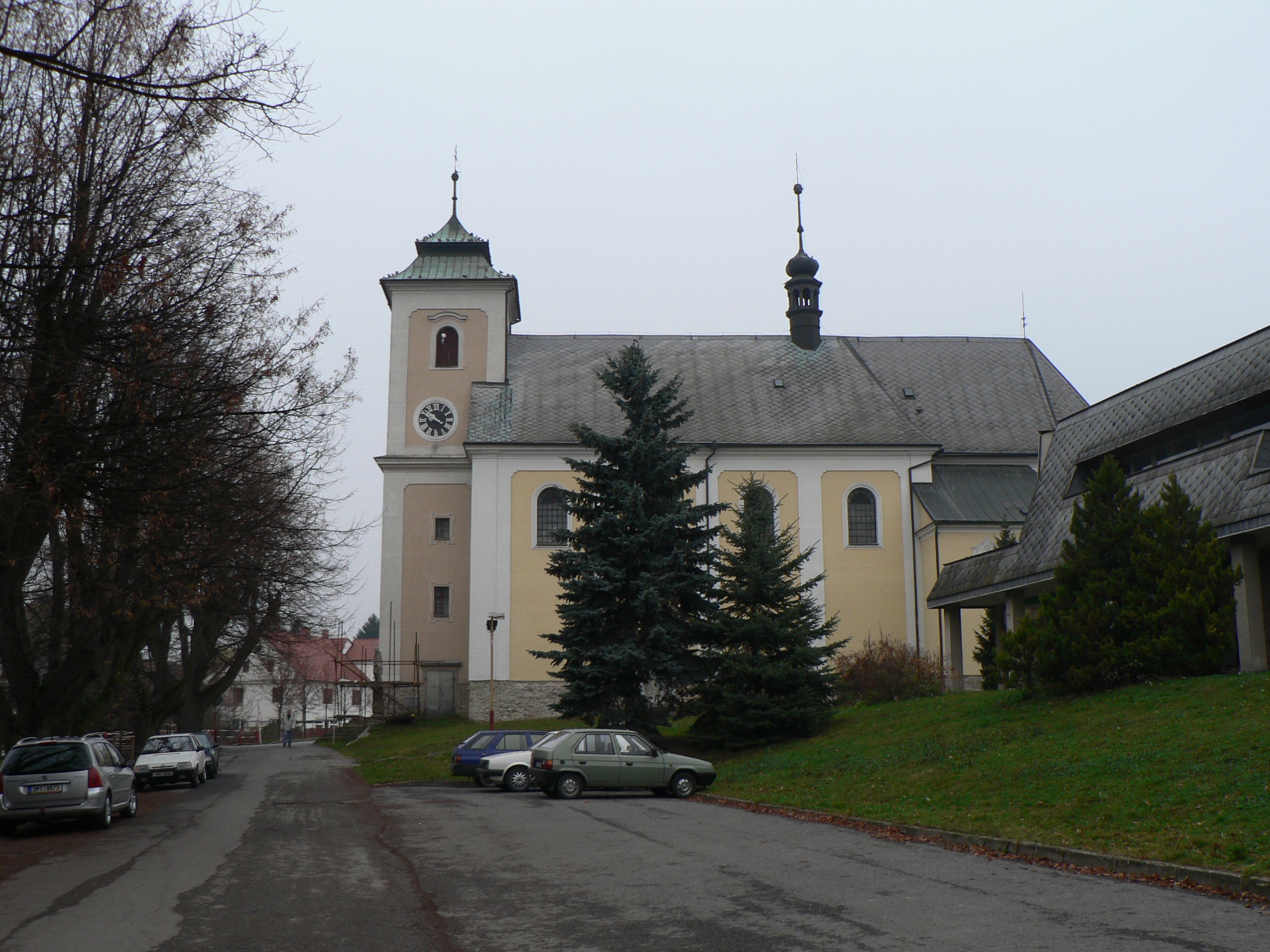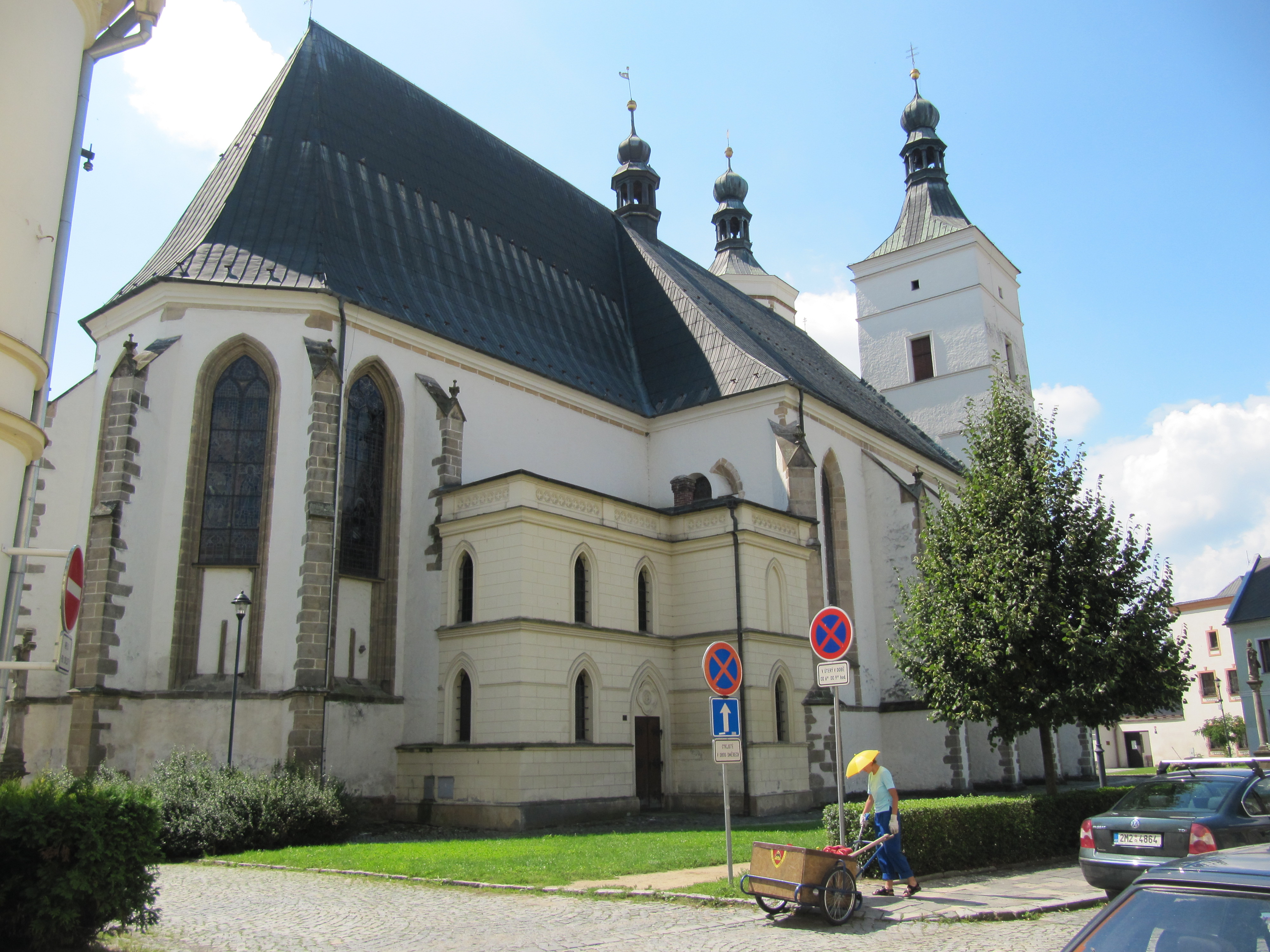|
Libina
Libina (german: Liebau) is a municipality and village in Šumperk District in the Olomouc Region of the Czech Republic. It has about 3,300 inhabitants. Administrative parts The villages of Dolní Libina and Obědné are administrative parts of Libina. Geography Libina is located about southeast of Šumperk and north of Olomouc. The municipal territory lies mostly in the Hanušovice Highlands, however, the built-up area is located in the northernmost tip of the Upper Morava Valley. The highest point is the hill Mladoňovský vrch at above sea level. History Libina was probably founded in the second half of 13th century. The first written mention of Libina is from 1358. In the 14th, 15th and 16th centuries, it was owned by noble families of Sternberg, Cymburk and Zierotin. In 1568, Bedřich the Elder of Zierotin sold the village to the town of Uničov. Demographics Transport Libina is located on the railway line Šumperk–Vyškov Vyškov (; german: Wischau) is a town in the ... [...More Info...] [...Related Items...] OR: [Wikipedia] [Google] [Baidu] |
Jaroslav Erik Frič
Jaroslav Erik Frič (14 August 1949, Libina – 24 May 2019, Brno) was a Czech poet, musician, publisher and organizer of underground culture festivals. Life and career Born in Libina by Šumperk, he studied the primary and secondary schools in Ostrava; there he also spent a year learning English, Russian, French and Italian at a language school. In 1968, he travelled through the Western Europe immediately after the exams, spending most of the time in England and Scotland. During this time, he earned money for example as a busker. He returned to occupied Czechoslovakia and studied English and philosophy, at first in Olomouc ( Palacký University), then in Brno (Masaryk University). He graduated in 1974. Not willing to collaborate with the communist regime in any way, he worked as a waiter until the 1989 revolution. In 1969, Frič started to publish in samizdat, together with fellow poets Petr Mikeš and Eduard Zacha, in Ostrava and then in Olomouc. His edition, after a theologi ... [...More Info...] [...Related Items...] OR: [Wikipedia] [Google] [Baidu] |
Šumperk District
Šumperk District ( cs, okres Šumperk) is a district ('' okres'') within the Olomouc Region of the Czech Republic Its administrative centre is the town of Šumperk. Šumperk District shares border with the districts of Olomouc (to the south), Svitavy District (to the south-west), Ústí nad Orlicí District (to the north-west), Polish Kłodzko County (to the north), Jeseník District (to the north-east) and Bruntál District (to the east). Geography Šumperk District is a part of Moravia, except an area around Malá Morava village and Štíty town, which belong to Bohemia. The highest point is the Praděd mountain (1492 meters) situated on a north, the lowest point is a floodplain of Morava river (339 meters) south of Loštice town. District's surface is mostly mountainous and hilly. Wide lowland of Mohelnická brázda depression is situated in the center and most population lives there. Demography According to 2011 census, Šumperk District had 126 567 inhabitants. The di ... [...More Info...] [...Related Items...] OR: [Wikipedia] [Google] [Baidu] |
Hanušovice Highlands
Hanušovice Highlands ( cs, Hanušovická vrchovina, german: Hannsdorfer Bergland) are highlands within the Eastern Sudetes mountain range that runs between Poland and the Czech Republic. It is named after Hanušovice town. The area is 793 km² and its average elevation is 527.2 meters. The highest peak is Jeřáb with above sea level. The highlands mostly consists of crystallized slate and Paleozoic folded sediments with Neogene and Quaternary The Quaternary ( ) is the current and most recent of the three periods of the Cenozoic Era in the geologic time scale of the International Commission on Stratigraphy (ICS). It follows the Neogene Period and spans from 2.58 million years ... sediments in lower parts. Isolated rocks often occur on highland peaks. Mountain ranges of the Czech Republic Sudetes Geography of the Moravian-Silesian Region Highlands {{MoraviaSilesia-geo-stub ... [...More Info...] [...Related Items...] OR: [Wikipedia] [Google] [Baidu] |
Andrea Palladio
Andrea Palladio ( ; ; 30 November 1508 – 19 August 1580) was an Italian Renaissance architect active in the Venetian Republic. Palladio, influenced by Roman and Greek architecture, primarily Vitruvius, is widely considered to be one of the most influential individuals in the history of architecture. While he designed churches and palaces, he was best known for country houses and villas. His teachings, summarized in the architectural treatise, ''The Four Books of Architecture'', gained him wide recognition. The city of Vicenza, with its 23 buildings designed by Palladio, and 24 Palladian villas of the Veneto are listed by UNESCO as part of a World Heritage Site named City of Vicenza and the Palladian Villas of the Veneto. The churches of Palladio are to be found within the "Venice and its Lagoon" UNESCO World Heritage Site. Biography and major works Palladio was born on 30 November 1508 in Padua and was given the name Andrea di Pietro della Gondola. His father, Pietro, ... [...More Info...] [...Related Items...] OR: [Wikipedia] [Google] [Baidu] |
České Dráhy
České dráhy (English: ''Czech Railways''), often shortened to ČD, is the major railway operator in the Czech Republic providing regional and long-distance services. Overview The company was established in 1993, after the dissolution of Czechoslovakia, as a successor of the Czechoslovak State Railways. It is a member of the International Railway Union (UIC Country Code for the Czech Republic is 54)Community of European Railwaysand the Organization for Railway Cooperation (Asia and Europe). With twenty-four thousand employeesAnnual Report of České dráhy, a.s. for the Year 2014, auditor Deloitte Audit s.r.o. ČD Group is the fifth largest Czech company by the number of employees. Until 1 July 2008, České dráhy was the biggest employer in the Czech Republic. After experiencing regular losses and requiring government subsidy, the railway reported its first ever profit in 2007 while still receiving government subsidy. Attempts to make it more efficient are currently ongoi ... [...More Info...] [...Related Items...] OR: [Wikipedia] [Google] [Baidu] |
Vyškov
Vyškov (; german: Wischau) is a town in the South Moravian Region of the Czech Republic. It has about 20,000 inhabitants. The historic town centre is well preserved and is protected by law as an urban monument zone. Administrative parts Vyškov is made up of town parts and villages of Vyškov-Město, Vyškov-Předměstí, Brňany, Dědice, Hamiltony, Křečkovice, Lhota, Nosálovice, Nouzka, Opatovice, Pařezovice, Pazderna and Rychtářov. Geography Vyškov is located about east of Brno. It lies mostly in the Vyškov Gate. The northwestern part of the municipal territory extends into the Drahany Highlands and includes the highest point of Vyškov, the hill Kuchlov at above sea level. The Haná River, formed by the confluence of the Velká Haná and Malá Haná streams in Dědice, flows through the town. Opatovice Reservoir was built on the Malá Haná in 1972. It serves primarily for water supply. History The first written mention of Vyškov is from 1141, in a deed of bi ... [...More Info...] [...Related Items...] OR: [Wikipedia] [Google] [Baidu] |
Uničov
Uničov (; german: Mährisch Neustadt) is a town in Olomouc District in the Olomouc Region of the Czech Republic. It has about 11,000 inhabitants. The historic town centre is well preserved and is protected by law as an urban monument zone. Administrative parts Villages of Benkov, Brníčko, Dětřichov, Dolní Sukolom, Horní Sukolom, Nová Dědina, Renoty and Střelice are administrative parts of Uničov. Geography Uničov is located about northwest of Olomouc. It lies in the Upper Morava Valley lowland on the Oslava River. History Uničov is one of the seven royal Moravian towns. It was founded around 1213 by the Margrave Vladislaus III, the brother of King Ottokar I of Bohemia. It received Magdeburg rights in 1223 and was granted further privileges by Ottokar's successor King Wenceslaus I in 1234. The town was to become a centre of ore and precious metal mining, but the deposits were not so plentiful. The town therefore reoriented itself to trade and crafts, and in 1327 ... [...More Info...] [...Related Items...] OR: [Wikipedia] [Google] [Baidu] |
Zierotin
The House of Žerotín or House of Zierotin was a Czech noble family in the Lands of the Bohemian Crown, one of the oldest and most illustrious noble families from Bohemia and Moravia. The family was first mentioned around the year 1200 as ''Bludovici'' (Blud of Bludov), later renamed ''Žerotínové'', and achieved the rank of Imperial Counts in the Holy Roman Empire. The male line of this family died out in 1985. Its estates, manor Bludov, were returned to their female descendants, the family Mornstein-Zierotin after fall of Communist rule in 1989. History According to romantic legend, the Zierotins were the offspring of Prince Oleg of Drelinia, brother of Vladimir I of Kiev, and therefore the family uses in its coat of arms a royal crown (or more properly the crown of Grand Prince) and princely mantling. The heraldic device is a blazon of arms in gules (red) with a lion sable (black), crowned, on three mountains argent (silver). The crest is the crowned lion rampant. Membe ... [...More Info...] [...Related Items...] OR: [Wikipedia] [Google] [Baidu] |
Upper Morava Valley
Upper may refer to: * Shoe upper or ''vamp'', the part of a shoe on the top of the foot * Stimulant, drugs which induce temporary improvements in either mental or physical function or both * ''Upper'', the original film title for the 2013 found footage film ''The Upper Footage ''The Upper Footage'' (also known as ''Upper'') is a 2013 found footage film written and directed by Justin Cole. First released on January 31, 2013 to a limited run of midnight theatrical screenings at Landmark’s Sunshine Cinema in New York Cit ...'' See also {{Disambiguation ... [...More Info...] [...Related Items...] OR: [Wikipedia] [Google] [Baidu] |
Obec
Obec (plural: ''obce'') is the Czech language, Czech and Slovak language, Slovak word for a municipality (in the Czech Republic, in Slovakia and abroad). The literal meaning of the word is "Intentional community, commune" or "community". It is the smallest administrative unit that is governed by elected representatives. Cities and towns are also municipalities. Definition Legal definition (according to the Czech code of law with similar definition in the Slovak code of law) is: ''"The municipality is a basic territorial self-governing community of citizens; it forms a territorial unit, which is defined by the boundary of the municipality."'' Every municipality is composed of one or more cadastre, cadastral areas. Every municipality is composed of one or more administrative parts, usually called town parts or villages. A municipality can have its own flag and coat of arms. Czech Republic Almost whole area of the republic is divided into municipalities, with the only exception be ... [...More Info...] [...Related Items...] OR: [Wikipedia] [Google] [Baidu] |
Regions Of The Czech Republic
Regions of the Czech Republic ( cs, kraj, plural: ''kraje'') are higher-level territorial self-governing units of the Czech Republic. Every region is governed by a regional council, headed by a governor (''hejtman''). Elections to regional councils take place every four years. According to the Act no. 129/2000 Coll. ("Law on Regions"), which implements Chapter VII of the Czech Constitution, the Czech Republic is divided into thirteen regions and one capital city with regional status as of 1 January 2000. History The first ''kraje'' were created in the Kingdom of Bohemia during the reign of Charles IV in the 14th century and they lasted till 1862/68. ''Kraje'' were reintroduced in 1949 in Czechoslovakia and still exist today (except for the early 1990s) in its successor states despite many rearrangements. Competences Rights and obligations of the regions include: *Establishment of secondary schools; *Responsibility for hospitals and social facilities; *Construction and repai ... [...More Info...] [...Related Items...] OR: [Wikipedia] [Google] [Baidu] |




.jpg)

